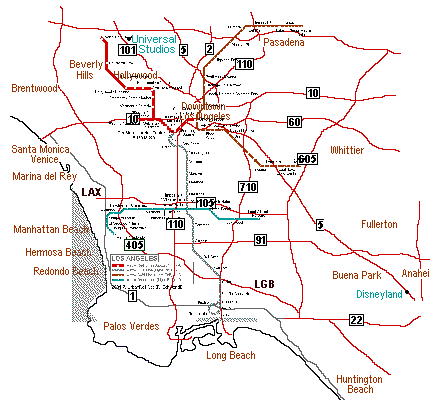

|
| weblog/wEssays | home | |
|
I Love L.A., But... It's All About Cheap Oil August 29, 2005  My stepmother, who is Mexican-American, was directing us to one of their favorite Mexican restaurants
in Highland Park, a working-class neighborhood in Los Angeles, when my Dad pointed to the wide median strip
dividing the thoroughfare. "That was where the streetcar to downtown L.A. used to run," he noted, and
it called up images of a bygone era. A streetcar to downtown; imagine!
My stepmother, who is Mexican-American, was directing us to one of their favorite Mexican restaurants
in Highland Park, a working-class neighborhood in Los Angeles, when my Dad pointed to the wide median strip
dividing the thoroughfare. "That was where the streetcar to downtown L.A. used to run," he noted, and
it called up images of a bygone era. A streetcar to downtown; imagine!
The story about how a consortium of tire manufacturers and General Motors bought up the streetcar companies and promptly shut them down is well-known, as is the recent construction of L.A.'s Metro, a light-rail system of four lines: red (Hollywood to downtown), blue (Long Beach to downtown), green (Redondo to Norwalk) and gold (Pasadena to downtown). My poor map is a crude overlay of two transport systems in the L.A. basin: the thin red lines are freeways and the other colored lines are Metro lines. A quick glance reveals that the freeway system is more extensive than the limited reach of the four metro lines. While the Metro is a great start, the vast expanse of the L.A. basin cannot be traversed except by car. Hence: it's all about oil. Yes, crude oil has been pumped out of the basin for decades, but the oil which now controls the region is the refined form which millions of thirsty vehicles require each day to move freely about the basin and beyond. L.A.'s geography and lack of public transit lead to one inescapable conclusion: this is a city dependent on cheap oil. If oil doesn't stay cheap, then L.A.'s 14 million residents (and 13.9 million drivers) will need 13.9 million hybrid or LEV (low emission vehicle) cars and trucks in short order, or they won't be able to afford getting to work. I am a big proponent of bicycles, but you have to live within five miles of your job to make riding a bike to work feasible, and it would seem few in L.A. live that close to their employer--or close enough to make use of the gleaming new Metro lines. Conservation is always the easiest and cheapest solution, and for an example I turn to my humble 1998 Honda Civic, which required 10.3 gallons of gas to travel the 380 miles to Pasadena, or roughly 37 miles to the gallon--and that's with the air conditioner on for 95% of the ride. This is equivalent to all but the smallest hybrid vehicles, and without the added engineering cost of a hybrid. It's simply a small, low-emission gasoline engine powering a light vehicle. No magic there. And there's no magic in calculating that this engine could easily power a small truck or minivan, with the one caveat that acceleration would be somewhat slower than in the Civic. But which would you choose? A vehicle that gets 40 miles to the gallon, or pumped-up acceleration? Your answer might change at, say, $4 per gallon. * * * copyright © 2005 Charles Hugh Smith. All rights reserved in all media. I would be honored if you linked this wEssay to your site, or printed a copy for your own use. * * * |
||
| weblog/wEssays | home |